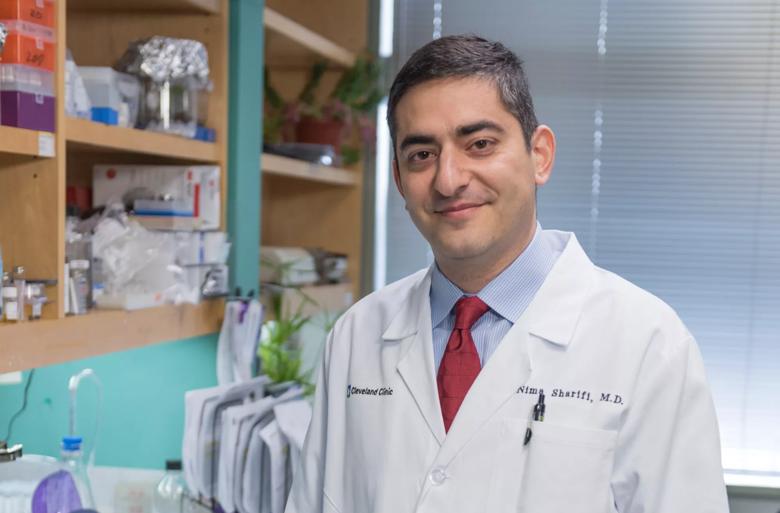Testosterone-related genetic abnormality can help predict patient responses to prostate cancer therapies
Cleveland Clinic News Service | 216.444.0141
We’re available to shoot custom interviews & b-roll for media outlets upon request.
CCNS health and medical content is consumer-friendly, professional broadcast quality (available in HD), and available to media outlets each day.

Back-to-back discoveries from Cleveland Clinic demonstrate for the first time how a testosterone-related genetic abnormality can help predict individual patient responses to specific prostate cancer therapies.

The studies, published in the October 12 issue of JAMA Oncology, suggest that men who inherit this variant would benefit from a personalized treatment plan that targets specific hormonal pathways.
The research teams, led by Nima Sharifi, M.D., of the Cleveland Clinic Lerner Research Institute, studied the role of the HSD3B1(1245C) genetic variant in two different prostate cancer patient populations, following androgen deprivation therapy (ADT). ADT works by blocking prostate cancer’s supply of male hormones in the testes. It is a cornerstone treatment for recurrent prostate cancer, but it often stops working, allowing cancer to progress and spread. In 2013, Dr. Sharifi discovered that prostate cancer cells with the genetic abnormality survive ADT by producing their own androgens.
“We are hopeful that these findings will lead to more personalized and effective treatments for prostate cancer,” Dr. Sharifi said. “If men carry a specific testosterone-related genetic abnormality we may be able to personalize their therapy and treat specific patients more aggressively.”
In the first new study, Dr. Sharifi and colleagues from Memorial Sloan Kettering Cancer Center, Harvard/Dana-Farber Cancer Institute and University of Michigan Comprehensive Cancer Center analyzed 213 men whose prostate cancer recurred after radiation therapy and underwent ADT. They found for the first time that following radiation and ADT, prostate cancer was much more likely to spread—and spread rapidly—in men who had the HSD3B1(1245C) variant.
The second study, performed in collaboration with researchers at University of California San Francisco, examined a group of 90 men with metastatic cancer that had become resistant to ADT. These patients were subsequently treated with the drug ketoconazole, which blocks the production of androgens outside of the testes (e.g., those developed by prostate cancer cells that are evading ADT treatment).
Surprisingly, men with the genetic anomaly fared better on ketoconazole than men without the variant. This finding raises the possibility that targeting variant tumors’ backup androgen supply (outside of the testes) could be a successful strategy when ADT fails.
“We hypothesized that HSD3B1(1245C) variant tumors become resistant to ADT because they have a backup supply of androgens,” said Dr. Sharifi. “However, relying on these extra-gonadal androgens makes them more sensitive to ketoconazole.”
These discoveries complement earlier studies and support the use of HSD3B1(1245C) as a predictive biomarker to help guide critical treatment decisions. While the outlook of patients with this gene variant is poor, these studies offer hope for a new treatment strategy for these men, and more studies are needed using next-generation androgen inhibitors, such as abiraterone and enzalutamide.
Dr. Sharifi is also a member of the Glickman Urological and Kidney Institute and Taussig Cancer Institute of Cleveland Clinic. He holds the Kendrick Family Chair for Prostate Cancer Research at Cleveland Clinic and co-directs Cleveland Clinic’s Center of Excellence for Prostate Cancer Research. In 2017 he received a Top Ten Clinical Research Achievement award from the Clinical Research Forum for his landmark discovery that men who carry the HSD3B1(1245C) variant are more likely to die from their disease.
This work was supported by the U.S. Department of Defense, Howard Hughes Medical Institute, Prostate Cancer Foundation, American Cancer Society, the U.S. Army Medical Research and Materiel Command and grants from the National Cancer Institute.

Nima Sharifi, M.D.

Nima Sharifi, M.D.

Nima Sharifi, M.D.
Cleveland Clinic is a nonprofit multispecialty academic medical center that integrates clinical and hospital care with research and education. Located in Cleveland, Ohio, it was founded in 1921 by four renowned physicians with a vision of providing outstanding patient care based upon the principles of cooperation, compassion and innovation. Cleveland Clinic has pioneered many medical breakthroughs, including coronary artery bypass surgery and the first face transplant in the United States. Cleveland Clinic is consistently recognized in the U.S. and throughout the world for its expertise and care. Among Cleveland Clinic’s 82,600 employees worldwide are more than 5,786 salaried physicians and researchers, and 20,700 registered nurses and advanced practice providers, representing 140 medical specialties and subspecialties. Cleveland Clinic is a 6,728-bed health system that includes a 173-acre main campus near downtown Cleveland, 23 hospitals, 280 outpatient facilities, including locations in northeast Ohio; Florida; Las Vegas, Nevada; Toronto, Canada; Abu Dhabi, UAE; and London, England. In 2024, there were 15.7 million outpatient encounters, 333,000 hospital admissions and observations, and 320,000 surgeries and procedures throughout Cleveland Clinic’s health system. Patients came for treatment from every state and 112 countries. Visit us at clevelandclinic.org. Follow us at x.com/CleClinicNews. News and resources are available at newsroom.clevelandclinic.org.
Editor’s Note: Cleveland Clinic News Service is available to provide broadcast-quality interviews and B-roll upon request.